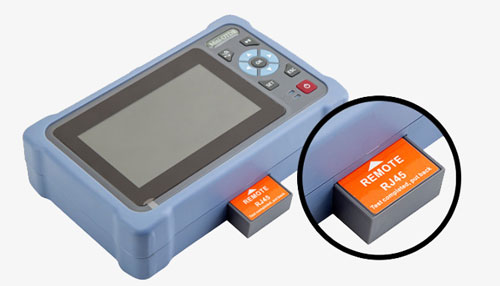Mini otdr fiber optic tester for measuring fiber length, loss, connection quality and other parameters, optical time domain reflectometer built-in 8G memory card, which can store up to 200,000 curves, 4,000mAh lithium battery with intelligent power-saving technology to ensure 12 hours of continuous testing, standby 20 hours, suitable for long field work.

12 in 1 multifunctional mini OTDR tester
- Support 12 functions: Automatic OTDR, Expert OTDR, Event Map, Optical Power Meter, Visible Red Light, Adjustable Light Source, Optical Loss Test, RJ45 Network Cable Pairing, RJ45 Network Cable Ranging, RJ45 network cable line finding, Flashlight, Endface Inspection.
- Single mode functional OTDR tester equipped with a high-performance chip, performance + energy efficiency double enhancements, smooth operation, accurate measurement, and intelligent battery management makes the battery life also greatly enhanced.
- Large-capacity polymer battery, stable current, long-lasting battery life, safe to use, standby longer than 20 hours.
- 8G storage capacity, support auto-save, SOR format, PDF format, can store 200,000 items.
Application
OTDR (optical time domain reflectometer) uses the backward scattered light generated when the light propagates in the fiber to obtain attenuation information, which can be used to measure fiber attenuation, splice loss, fiber fault location and understand the loss distribution along the length of the fiber, etc. OTDR tester is an essential tool in fiber optic cable construction, maintenance, and monitoring.

| Model | SISCO-TM400S |
| Wavelength | 1550nm |
| Dynamic Range | 24dB |
| Display | 4.3 inch multi-touch capacitive screen |
| Output Power | 10mW |
| Operating Mode | CW/1Hz/2Hz |
| Fiber Type | G.652 single-mode fiber |
| Event Blind Zone | 2.5m |
| Attenuation Blind Area | 8m |
| Measurement Range | 500m, 1km, 2km, 4km, 8km, 16km, 32km, 64km, 100km |
| Pulse Width | 3ns~20us |
| Distance Measurement Accuracy | ±( 1m+sampling interval+0.005 % x test distance) |
| Linearity | ±0.05dB/dB |
| Sampling Points | 16k~128k |
| Sampling Resolution | 0.05m~8m |
| Reflection Accuracy | ±3dB |
| Data Storage | 8G |
| Laser Safety Level | Class2 level |
| File Format | SOR standard file format |
| Optical Connector | FC/UPC (interchangeable SC, ST); optional SC/APC |
| Data Interface | Type-C |
| Extended External Storage | TF card |
| Power Supply | Li-polymer battery: 3.7V, 4000mAh |
| Power Adapter | 5VDC, 2A |
| Battery Life | Standby>20 hours, measurement>12 hours |
| Weight | 500g |
| Working Temperature | -10℃~+55℃ |
| Storage Temperature | -20℃~+80℃ |
Q1: What is an OTDR used for?
A1: OTDR is a fiber optic instrument used to characterize, troubleshoot and maintain optical communication networks. OTDR testing is performed by transmitting and analyzing pulsed laser light through an optical fiber.
Q2: What is fiber loss?
A2: Optical fiber loss is the attenuation per unit length of optical fiber in dB/km, the level of fiber loss directly affects the transmission distance or the distance between relay stations, therefore, understanding and reducing the loss of optical fiber is of great practical significance for fiber optic communication.
Q3: What is an optical time domain reflectometer?
A3: The optical time domain reflectometer is a fiber optic tester used to test the characteristics of optical communication networks. OTDR is designed to detect, locate and measure events at any location on a fiber optic link. OTDR requires access to only one end of the link and works in a manner similar to a one-dimensional radar system. By providing graphical trace characteristics of the fiber under test, the user can obtain a graphical representation of the entire fiber link.
Tips: How to identify and deal with ghosting (secondary reflection peaks)?
The spikes on the OTDR curve are sometimes due to echoes caused by closer and stronger reflections from the incident end, and such spikes are called ghost images. Identifying ghosting: The ghosting on the curve does not cause significant loss. The distance between the ghost image and the beginning of the curve is a multiple of the distance between the strong reflection event and the beginning, in a symmetrical shape. Eliminate ghosting: Select a short pulse width and add attenuation in the strongly reflective front end (e.g. OTDR output). If the event causing the ghosting is located at the end of the fiber, you can "make a small bend" to attenuate the light reflected back to the beginning.
Thank you for buying industrial test and measurement equipment on SISCO.com, all products sold by SISCO and the partner cover a 12 months warranty, effective from the date of receiving the products.
What is covered?
SISCO is responsible for providing free spare parts, and free technical support to assist the customer to repair the defective products until the problem is solved.
What is not covered?
- Product purchased from anyone other than a SISCO store or a SISCO authorized reseller.
- Expendable parts.
- Routine cleaning or normal cosmetic and mechanical wear.
- Damage from misuse, abuse or neglect.
- Damage from use of parts other than SISCO approved.
- Damage from use outside the product’s usage or storage parameters.
- Damage from use of parts not sold by SISCO.
- Damage from modification or incorporation into other products.
- Damage from repair or replacement of warranted parts by a service provider other than a SISCO authorized service provider.
- Damage caused by the application environment not meeting the product usage requirements and the failure to perform preventive maintenance.

